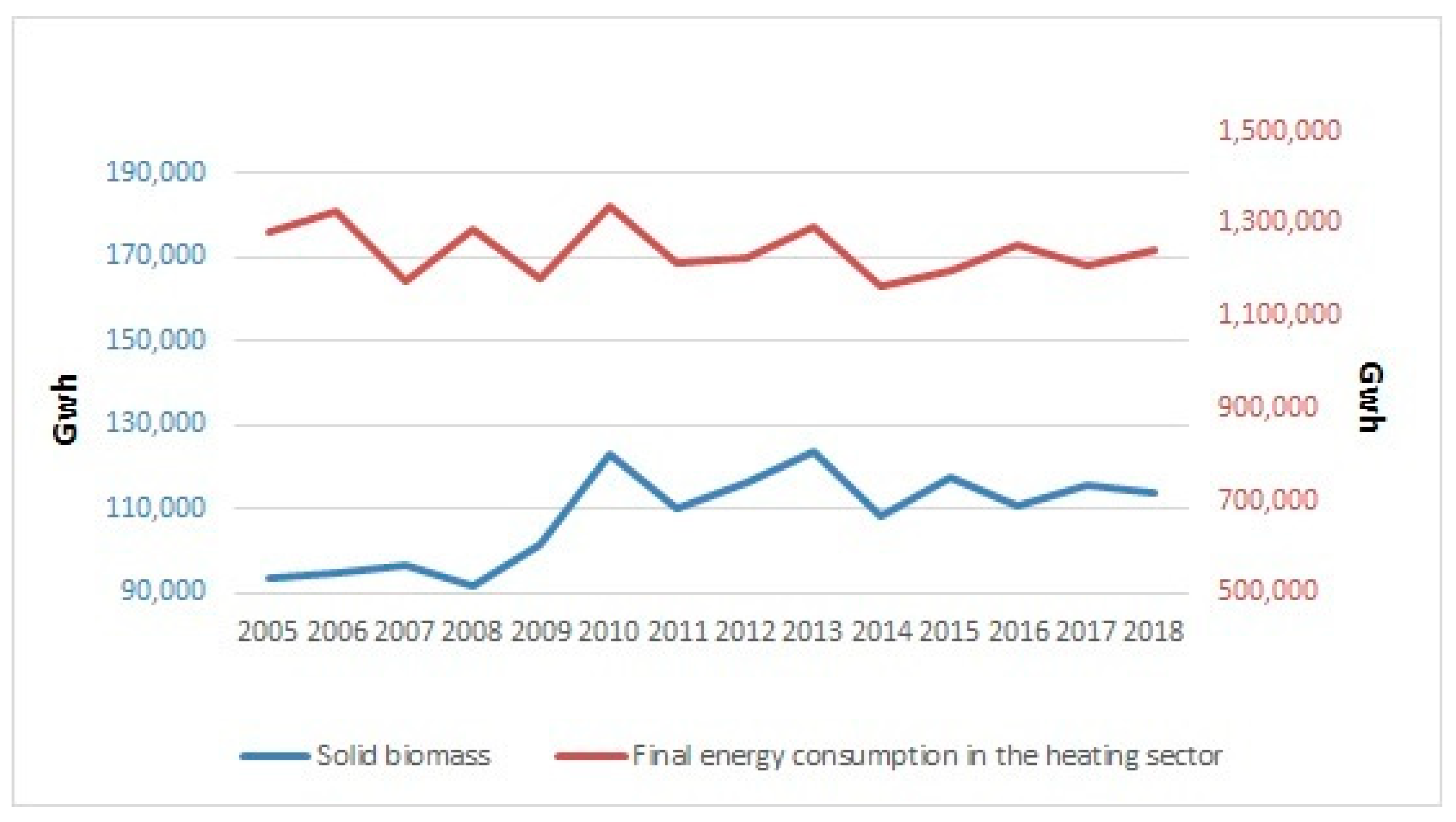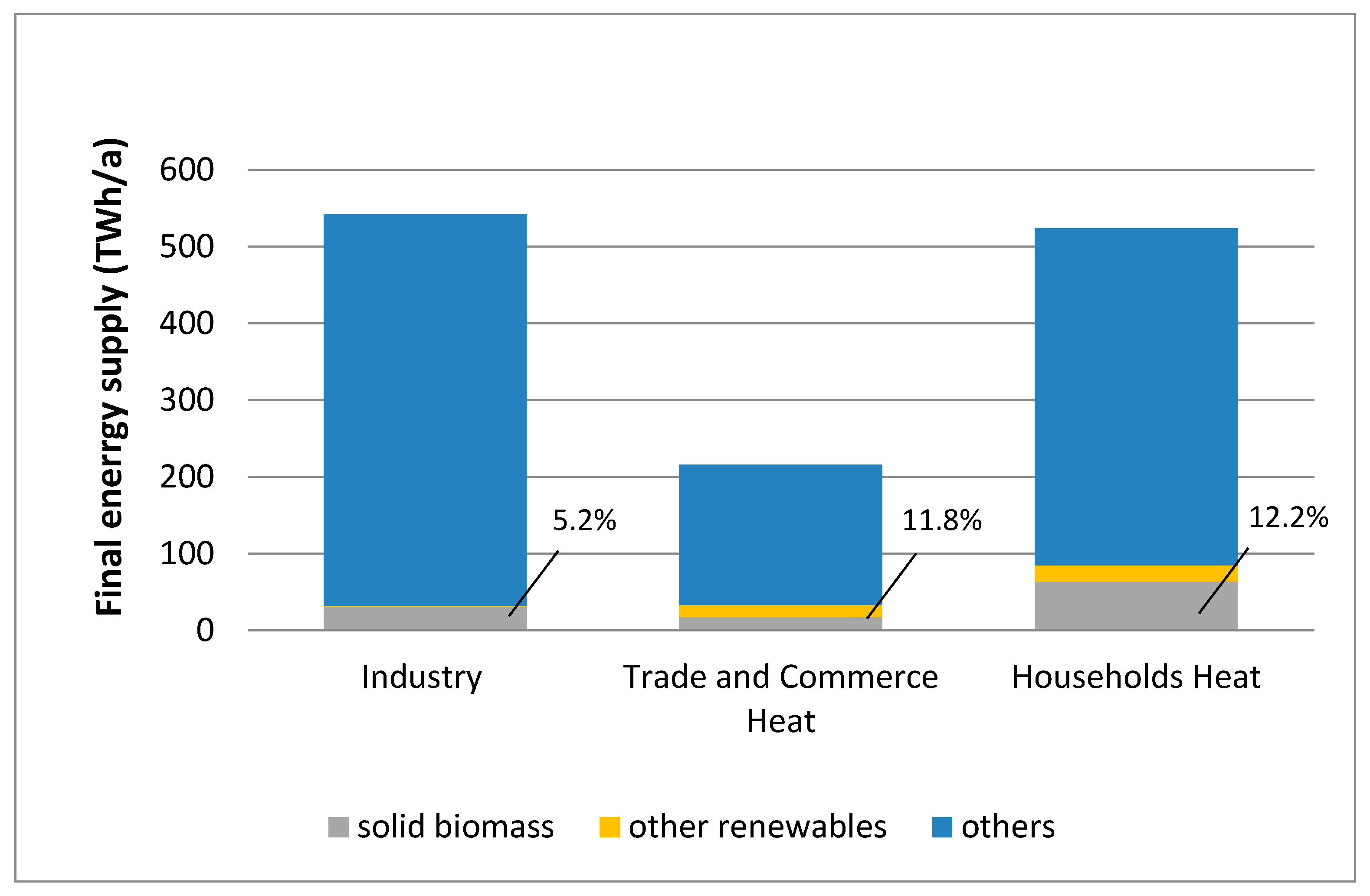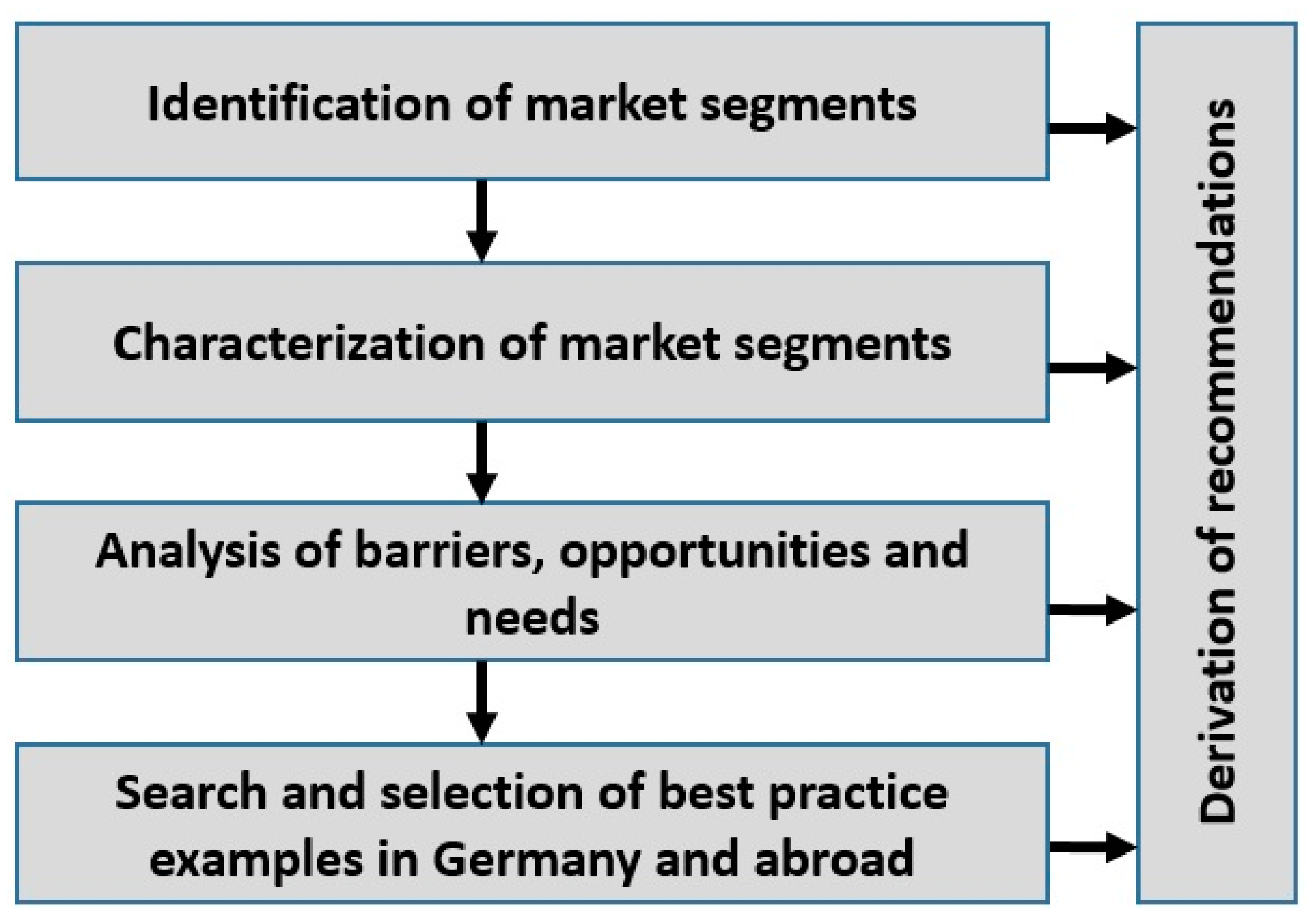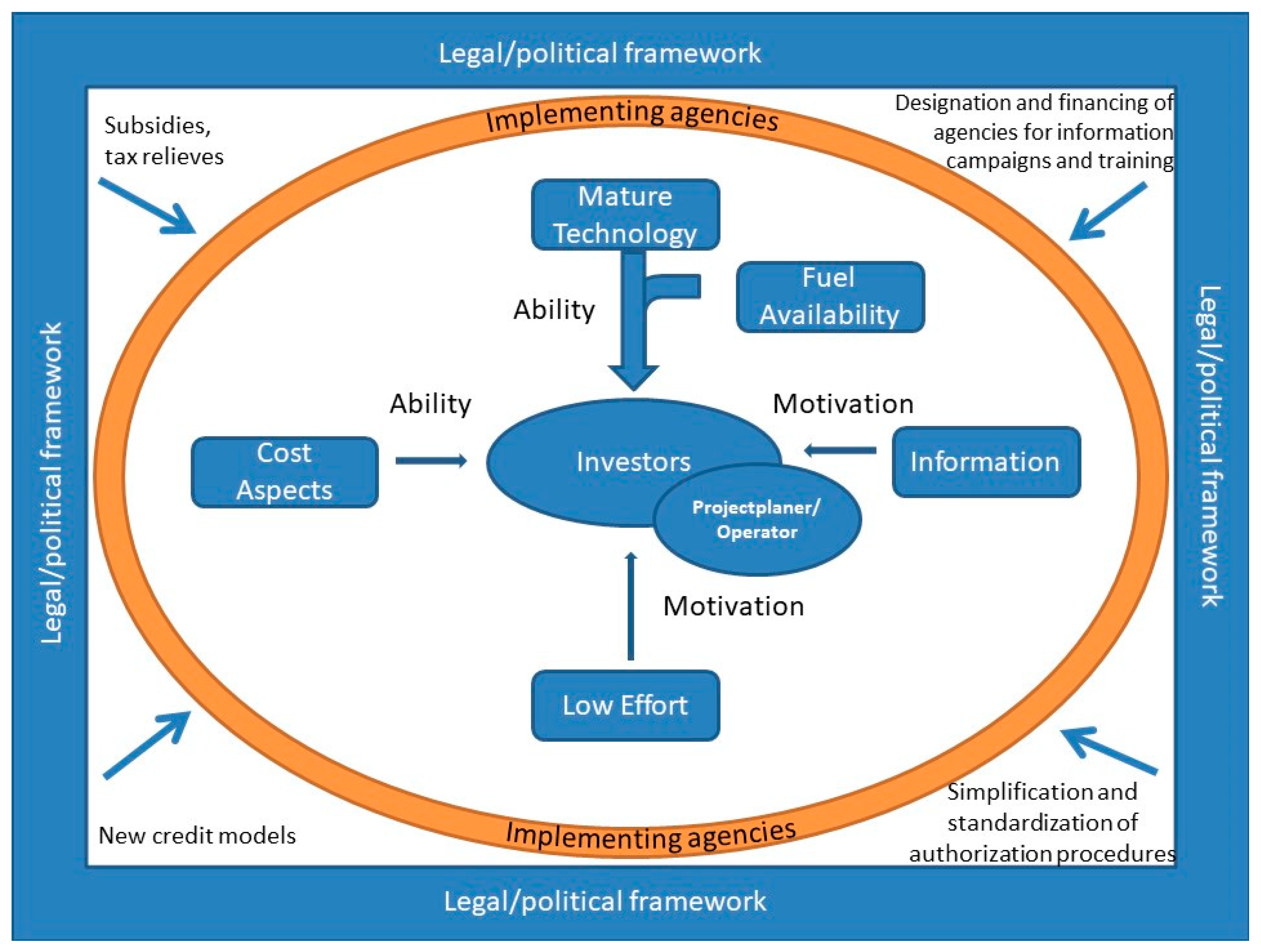Nine Measures to Take—Unlocking the Potential for Biomass Heat in the German Industry and the Trade, Commerce, and Service Sector
Abstract
1. Introduction
2. Materials and Methods
2.1. General Approach
2.2. Identification of Market Segments with Unexploited Potential and Relevant Key Factors for Implementing Bioheat Concepts
- three major German biomass plant manufacturers;
- one stakeholder in contracting and energy services who has extensive experience with the implementation of biomass-based projects;
- an engineering office that has already implemented several biomass heating plants in the industry, and TCS commerce, trade and services sector, and which offers neutral and independent planning services (see also Appendix A, Table A1).
- paraphrasing: a factual reiteration of the content of the interview;
- thematic structure: divided into individual thematic sections;
- thematic comparison: comparison of the text passages of the various expert interviews, formation of thematic categories;
- comprehensive presentation of the expert assessment.
2.3. Characterization of Market Segments
2.4. Analysis of Barriers, Opportunities, and Needs
2.4.1. Interview of Financing Institutions
2.4.2. Interview with Relevant Stakeholders in the Promising Market Segments and their Upstream Supply Chain
2.4.3. Classification of Barriers and Solutions
- cost aspects: competitiveness in comparison with fossil (and other renewable) plant concepts;
- information: e.g., awareness of the target groups on the possible economic advantages and climate protection contribution of biomass heating systems; and
- low effort: the least possible expenditure of time and effort for planning, authorization, and construction of the plants.
2.5. Search and Selection of Best Practice Examples in Germany and Abroad
2.6. Derivation of Recommendations
3. Results
3.1. Selection and Characterization of Promising Market Segments
3.2. Barriers Identified in the Promising Markets
3.3. Nine Sets of Measures for Improvement
3.3.1. Prioritization of Renewable Heat Supply at Different Policy Levels
3.3.2. Support for Introducing Clean Technologies to the Market
3.3.3. Establishment of Energy Performance Contracting and Leasing
- they reduce the effort for planning and organizational implementation of energy efficiency measures;
- the technical and economic risk is transferred to the energy service company (ESCO);
- the heat consumers save the high investment costs and can use the liquid funds that remain free for their core business.
3.3.4. Quality Standards for Planning and Maintenance
3.3.5. Better Information about Tailored Supply Concepts Especially in the Woodchip Sector
3.3.6. Reducing Uncertainties in Fuel Quality
3.3.7. Reducing Uncertainty in the Sustainability Debate of Solid Biomass Fuels
3.3.8. Acceleration and Standardization of Approval Procedures
4. Discussion
Author Contributions
Funding
Conflicts of Interest
Appendix A
| Role | Company | Type of Business |
|---|---|---|
| Energy system planner | IDEE-Seeger | Planner of biomass district heating plant |
| Managing director | HDG-Bavaria | Biomass boiler manufacturer |
| Managing director | Heizomat | Biomass boiler manufacturer |
| Managing director | Viessmann Germany Industry GmbH | Biomass boiler manufacturer |
| Division manager for heating contract services | GBH Mieterservice Vahrenheide GmbH | Contractor |
| Organization/ Person Interviewed (PI) | Scope/Function |
|---|---|
| Biomass Suppliers | |
| Biomassehof Borlinghausen (biomass treatment plant) PI: Managing Director | Important biofuel supplier (12,000 tons per year). Product portfolio encompasses woodchips, DIN plus pellets (DIN—German Institute for Standardization) and briquettes for energetic use. |
| German Forestry Council (DFWR) PI: Managing Director | Represents forest management and all stakeholders in forests in Germany. Members are state forest management agencies, representatives of the German Association of Towns and Municipalities (DStGB), and the working group of the German Forest Owners Association (AGDW) for private forests. The association represents the interests of sustainable forest management and 2 million private and public forest owners. |
| Biomassehof Achental PI: CEO | The convincing economic concept of Biomassehof Achental gained the political support of the municipalities of Achental Valley. Approximately 8000 m³of premium woodchips are delivered annually to hotels, restaurants, and the health center. In addition, the Biomassehof train a large number of heating engineers as a preparation to play a key role in the implementation of heat concepts based on solid biomass fuels. Facility managers and heating engineers are trained on wood fuels and renewable energies, plant construction, energy saving measures, etc. |
| Demand Side | |
| Adelphie (consulting company) PI: Project Manager | Implements the national energy campaign for the German Hotel and Restaurant Association (DEHOGA). DEHOGA represents the interests of the German hospitality industry. |
| Sportbäder Leipzig GmbH PI: Technical Director | Operates 8 indoor swimming pools, 6 outdoor swimming pools, and 2 saunas. |
| Helios clinics PI: Manager of Central Technical Services | A member of the Fresenius Group, one of the largest hospital groups in Europe. In Germany, HELIOS operates 112 acute care hospitals and post-acute care clinics, representing 5% of all German hospitals. The Helios clinics operate 13 pellet plants. |
| Interest Organization/Policy Authority | |
| Ministry for the Environment of the federal state of Baden-Wuerttemberg PI: Member of the “energy industry” department, “renewable energies” unit | The department deals with the fundamental issues of energy politics, energy efficiency of buildings, energy efficiency in households and companies, renewable energies, and transport and storage networks. |
| The Wood Energy Association as a subunit of the German Bioenergy Association (BBE): PI: Managing Director | Holding organization of the German bioenergy market, representing the energy market in comprehensive areas (electricity, heat, and transportation). The Wood Energy Association represents the interest of energetic wood use. |
| Federal Ministry of Economic Affairs and Energy PI: Expert in the topic Bioenergy | Central priority is to lay the foundations for economic prosperity in Germany; one subtask is the realization and strategic planning of the transformation of the German energy system. |
| Regional Planning Association of West Saxony PI: Director | Body responsible for regional planning in Western Saxony. |
| Energy Agency of Saxony (SAENA): PI: Contact Person in “Energy” Service Center | Independent competence and information center for energy for the federal state of Saxony. |
| Financial Institutions [28] | |
| Commerzbank | Focuses specifically on the requirements of medium-sized companies, the public sector, and institutional clients. Focus is primarily on financing biomass-based heat concepts of medium-sized companies (with own substrate resources). |
| Volks- und Raiffeisenbank PI: Representative from the business field “Energy and Environment” | Has offered financing options for renewable energy projects for more than 25 years. Usually long-term investment loans are provided, whereby low-interest loans are primarily from KfW Bank and Landwirtschaftliche Rentenbank. |
| Investitionsbank Schleswig-Holstein PI: Head of Energy Agency | The SH investment bank is the only development bank that also has an energy agency. As part of the country’s energy and climate change initiative, free initial consultations are offered for municipal stakeholders and municipalities.Consortium partner of local banks – co-financing of projects. |
| Wirtschafts- und Infrastrukturbank Hessen | Up to 30% of the investment costs of woodchip and pellet-fired bioenergy plants are subsidized through a special agricultural support program of the federal state of Hesse. |
| Examples of Good Practice | |
| VILA VITA Holiday Resort Anneliese Pohl Seedorf PI: Plant Operator | The holiday resort has 160 beds in small apartment buildings, a restaurant, a multifunctional hall, and a spa area. All of its heating requirements are covered by a high-efficiency 400 kW base load (+500 kW backup and for further extension) cogeneration pellet plant, which supply the resort by a heating network. |
| Weißenstadt Health Resort PI: Plant operator | The health resort is supplied by the company Biomasseheizung Weißenstadt GmbH. There are two woodchip-fired biomass boilers, one for base load with an output of 550 KW, and one for peak load with an output of 300 KW. Local farmers ensure the fuel supply of the plant. |
| Clinical Center of Erlangen PI: Plant Operator | The Clinical Center of Erlangen has in total about 700 beds. Since 2004, approximately 97% of the heat demand has been supplied by a biomass heating plant, which is located next to the clinical center. Net capacity of the biomass boiler is 4.3 MW base load. Investor and operator of the system is the biomass treatment works (Kompostier Betriebs GmbH Erlangen-Höchstadt). |
| Obernsees Thermal Bath PI: Plant operator | The Obernsees Thermal Bath and has a thermal pool and an adventure area. Since November 1997, a biomass heating plant, which was built next to the water park, covers the heat demand of the bath. The investor and operator of the system is the Biomasse Heizanlage Obernsees GmbH (BHO). Shareholders are the MR Agrarservice GmbH, the Bayernwerke Natur (energy provider), which develop individualized energy solutions on the basis of renewable sources. Net capacity of the biomass boiler(s) 1.25 MW base load (400 kW + 850 kW). |
References
- Bertram, R.; Primova, R. Energy Atlas 2018: Facts and Figures about Renewables in Europe. Available online: https://www.boell.de/sites/default/files/energyatlas2018_facts-and-figures-renewables-europe.pdf.pdf (accessed on 12 July 2019).
- Bundesministerium für Wirtschaft und Energie (BMWi). Energieeffizienz in Zahlen: Entwicklungen und Trends in Deutschland 2019. Available online: www.bmwi.de/Redaktion/DE/Publikationen/Energie/energieeffizienz-in-zahlen-2019.pdf?__blob=publicationFile&v=72 (accessed on 28 July 2020).
- Bundesministerium für Umwelt, Naturschutz, Bau und Reaktorsicherheit (BMUB). Klimaschutzplan 2050. Klimaschutzplan 2050 Klimaschutzpolitische Grundsätze und Ziele der Bundesregierung. 2016. Available online: https://www.bmu.de/fileadmin/Daten_BMU/Download_PDF/Klimaschutz/klimaschutzplan_2050_bf.pdf (accessed on 3 September 2020).
- Matthes, F.C.; Busche, J.; Döring, U.; Emele, L.; Gores, S.; Harthan, R.O.; Hermann, H.; Jörß, W.; Loreck, C.; Scheffler, M.; et al. Politikszenarien für den Klimaschutz IV. Climate Change. 2013. Available online: http://www.uba.de/uba-info-medien/4412.html (accessed on 3 September 2020).
- Bauchmüller, M. Deutschland Hinkt Seinem Klimaziel Hinterher. Süddeutsche, 11 October 2017. Available online: http://www.spiegel.de/wissenschaft/natur/klimaschutz-deutschland-produziert-zu-viel-co2-ziele-in-gefahr-a-1172368.html (accessed on 30 January 2018).
- Stryi-Hipp, G.; Baur, F.; Borggrefe, F.; Gerhardt, N.; Hauer, A.; Horst, J.; Huenges, E.; Kastner, O.; Lenz, V.; Martin, N.; et al. Erneuerbare Energien im Wärmesektor–Aufgaben, Empfehlungen und Perspektiven. Positionspapier des Forschungsverbunds Erneuerbare Energien. 2015. Available online: http://www.fvee.de/fileadmin/publikationen/Politische_Papiere_FVEE/15.EEWaerme/15_FVEE-Positionspapier_EE-Waerme.pdf (accessed on 3 September 2020).
- Umweltbundesamt AGEE-Stat. Erneuerbare Energien in Zahlen. Available online: https://www.umweltbundesamt.de/themen/klima-energie/erneuerbare-energien/erneuerbare-energien-in-zahlen#uberblick (accessed on 28 July 2020).
- Eurostat. Renewable Energy Statistics. Available online: https://ec.europa.eu/eurostat/statistics-explained/index.php/Renewable_energy_statistics#Share_of_renewable_energy_almost_doubled_between_2004_and_2018 (accessed on 28 July 2020).
- Sustainable Agribusiness Forum. Biomass for Heat. Bioenergy Europe Statistical Report 2019. Available online: https://saf.org.ua/en/news/722/ (accessed on 28 July 2020).
- Bundesministerium für Wirtschaft und Energie. Erneuerbare Energien in Zahlen 2015. Available online: https://www.bmwi.de/Redaktion/DE/Publikationen/Energie/erneuerbare-energien-in-zahlen-2018.pdf?__blob=publicationFile&v=22 (accessed on 3 September 2020).
- Bundesministerium für Wirtschaft und Energie (BMWi). Erneuerbare Energien in Zahlen. Nationale und Internationale Entwicklungen im Jahr 2017. 2018. Available online: https://www.bmwi.de/Redaktion/DE/Publikationen/Energie/erneuerbare-energien-in-zahlen-2017.pdf?__blob=publicationFile&v=29 (accessed on 28 July 2020).
- Lenz, V.; Szarka, N.; Jordan, M.; Thrän, D. Status and Perspectives of Biomass Use for Industrial Process Heat for Industrialized Countries. Chem. Eng. Technol. 2020, 43, 1469–1484. [Google Scholar] [CrossRef]
- Frauenhofer ISI. Erstellung von Anwendungsbilanzen für die Jahre 2018 bis 2020 für die Sektoren Industrie und GHD. Studie für die Arbeitsgemeinschaft Energiebilanzen e.V. (AGEB)—Entwurf. 2019. Available online: https://ag-energiebilanzen.de/8-0-Anwendungsbilanzen.html (accessed on 3 September 2020).
- Jordan, M.; Lenz, V.; Millinger, M.; Oehmichen, K.; Thrän, D. Future competitive bioenergy technologies in the German heat sector: Findings from an economic optimization approach. Energy 2019, 189, 116194. [Google Scholar] [CrossRef]
- Herhold, P.; Burchardt, J.; Schönberger, S.; Rechenmacher, F.; Kirchner, A.; Kemmler, A.; Wuensch, M.; Gerbert, P. Climate Paths for Germany. 2018. Available online: https://www.bcg.com/de-de/publications/2018/climate-paths-for-germany (accessed on 3 September 2020).
- Thrän, D.; Arendt, O.; Ponitka, J.; Braun, J.; Millinger, M.; Wolf, V.; Banse, M.; Schaldach, R.; Schüngel, J.; Gärtner, S.; et al. Meilensteine 2030. Elemente und Meilensteine für die Entwicklung Einer Tragfähigen und Nachhaltigen Bioenergiestrategie; Endbericht zu FKZ 03KB065, FKZ 03MAP230; DBFZ: Leipzig, Germany, 2015. [Google Scholar]
- Mantau, U. Holzrohstoffbilanzen und Stoffströme des Holzes–Entwicklungen in Deutschland 1987 bis 2016; Final Report; Hamburg: Gülzow-Prüzen, Germany, 2018. [Google Scholar]
- Oehmichen, K.; Röhling, S.; Dunger, K.; Gerber, K.; Klatt, S. Ergebnisse und Bewertung der Alternativen WEHAM-Szenarien. Available online: https://www.weham-szenarien.de/fileadmin/weham/Ergebnisse/AFZ_13_17_2_Ergebnisse_und_Bewertung_der_alternativen_WEHAM-Szenarien.pdf (accessed on 3 September 2020).
- Malico, I.; Nepomuceno Pereira, R.; Gonçalves, A.C.; Sousa, A.M.O. Current status and future perspectives for energy production from solid biomass in the European industry. Renew. Sustain. Energy Rev. 2019, 112, 960–977. [Google Scholar] [CrossRef]
- Bundesministerium für Wirtschaft und Energie (BMWi). Integrierter Nationaler Energie-und Klimaplan. Available online: https://www.bmwi.de/Redaktion/DE/Textsammlungen/Energie/necp.html (accessed on 28 July 2020).
- Bundesministerium für Naturschutz und Nukleare Sicherheit (BMU) 2019 Klimaschutzplan 2050. Klimaschutzpolitische Grundsätze und Ziele der Bundesregierung. Available online: https://www.bmu.de/fileadmin/Daten_BMU/Download_PDF/Klimaschutz/klimaschutzplan_2050_bf.pdf (accessed on 3 September 2020).
- Bertelsen, N.; Mathiesen, B.V. EU-28 Residential Heat Supply and Consumption: Historical Development and Status. Energies 2020, 13, 1894. [Google Scholar] [CrossRef]
- Baur, N.; Blasius, J. Handbuch Methoden der Empirischen Sozialforschung; Springer Fachmedien Wiesbaden: Wiesbaden, Germany, 2014; ISBN 978-3-531-18939-0. [Google Scholar]
- CrossBorder Bioenergy Working Group on District Heating. SECTOR HANDBOOK DISTRICT HEATING: Prepared by the CrossBorder Bioenergy Working Group on District Heating. Available online: http://www.crossborderbioenergy.eu/fileadmin/user_upload/Sector_Handbook_DH.pdf (accessed on 3 September 2020).
- Uslu, A.; van Stralen, J. Bioenergy Markets: The Policy Demand for Heat, Electricity and Biofuels, and Sustainable Biomass Supply: Results from Alternative Bioenergy Demand Scenarios for 2020 and 2030. Available online: https://www.ecn.nl/publications/PdfFetch.aspx?nr=ECN-L--12-004 (accessed on 19 December 2018).
- Viehmann, C.; Westerkamp, T.; Schwenker, A.; Schenker, M.; Thrän, D.; Lenz, V.; Ebert, M. Ermittlung des Verbrauchs Biogener Festbrennstoffe im Sektor Gewerbe, Handel, Dienstleistungen (GHD-Sektor); Endbericht; DBFZ: Leipzig, Germany, 2012. [Google Scholar]
- Romanian Association of Biomass and Biogas (ARBIO). Report on Bioenergy Business Models and Financing Conditions for Selected Countries. 2015. Available online: http://www.bioenergy4business.eu/wp-content/uploads/2015/06/D3.4-Report-on-bioenergy-business-models-and-financing-conditions-for-selected-countries.pdf (accessed on 12 July 2019).
- Rogers, E.M. Diffusion of Innovations, 4th ed.; Free Press: New York, NY, USA, 1995; ISBN 0028740742. [Google Scholar]
- Schmidt-Baum, T. Report on Frame Conditions for Realizing Bioenergy Heat Projects in Promising Market Segments. Available online: https://ec.europa.eu/research/participants/documents/downloadPublic?documentIds=080166e5b5d96471&appId=PPGMS (accessed on 3 September 2020).
- Bloche, K.; Schmidt-Baum, T. Germany’s Promising Market Segments for Heating with Solid Biomass (>100 kW). Country Summary Report of Promising Market Segments for Use of Bioenergy. Available online: https://ec.europa.eu/research/participants/documents/downloadPublic?documentIds=080166e5ad8cb0f0&appId=PPGMS (accessed on 3 September 2020).
- Romanian Association of Biomass and Biogas (ARBIO). Report Summarizing Best Practice Examples and Conclusions. 2015. Available online: https://ec.europa.eu/research/participants/documents/downloadPublic?documentIds=080166e5a33ed958&appId=PPGMS (accessed on 3 September 2020).
- Geiger, B.; Kleeberger, H.; Hardi, L. Erstellen der Anwendungsbilanzen 2013 bis 2017 für den Sektor Gewerbe, Handel, Dienstleistungen (GHD). 2019. Available online: https://www.google.com/url?sa=t&rct=j&q=&esrc=s&source=web&cd=&ved=2ahUKEwjN7IfrgcLqAhWEfZoKHdb5AksQFjABegQIAhAB&url=https%3A%2F%2Fag-energiebilanzen.de%2Findex.php%3Farticle_id%3D29%26fileName%3Dgeiger_ife_-_einzelbericht_gewerbe__handel__dienstleistungen_2013_-_2017.pdf&usg=AOvVaw19C2LE6a3vyAEcF1w3pbIX (accessed on 28 July 2020).
- Deutschen Gesellschaft für das Badewesen e.V. Bäderatlas. Available online: http://www.baederatlas.com/ (accessed on 28 July 2020).
- Statistisches Bundesamt. Statistisches Jahrbuch: Gastgewerbe und Tourismus. Available online: https://www.destatis.de/DE/Themen/Querschnitt/Jahrbuch/jb-gastgewerbe-tourismus.pdf?__blob=publicationFile (accessed on 28 July 2020).
- Kirschbaum, S. Branchenenergiekonzept Alten-und Pflegeheime NRW Energiekennzahlen. Available online: https://docplayer.org/19478057-Branchenenergiekonzept-alten-und-pflegeheime-nrw-energiekennzahlen.html (accessed on 28 July 2020).
- Gesundheitsberichtserstattung des Bundes (GBE). Pflegeheime und Verfügbare Plätze in Pflegeheimen. Gliederungsmerkmale: Jahre, Region, Art der Einrichtungen/Plätze, Träger. Available online: http://www.gbe-bund.de/oowa921-install/servlet/oowa/aw92/dboowasys921.xwdevkit/xwd_init?gbe.isgbetol/xs_start_neu/&p_aid=i&p_aid=35086526&nummer=570&p_sprache=D&p_indsp=-&p_aid=22910504 (accessed on 28 July 2020).
- Statistisches Bundesamt. Pflegeheime und Verfügbare Plätze in Pflegeheimen. Gliederungsmerkmale: Jahre, Region, Art der Einrichtungen/Plätze, Träger. 2017. Available online: http://www.gbe-bund.de/oowa921-install/servlet/oowa/aw92/WS0100/_XWD_PROC?_XWD_2/1/XWD_CUBE.DRILL/_XWD_30/D.100/10101#SOURCES (accessed on 12 July 2019).
- Statistisches Bundesamt. Krankenhäuser. 2017. Available online: http://www.gbe-bund.de/oowa921-install/servlet/oowa/aw92/dboowasys921.xwdevkit/xwd_init?gbe.isgbetol/xs_start_neu/&p_aid=3&p_aid=73227620&https://www.destatis.de/DE/Themen/Gesellschaft-Umwelt/Gesundheit/Krankenhaeuser/Tabellen/gd-krankenhaeuser-jahre.html (accessed on 12 July 2019).
- Verein Deutscher Zementwerke, e.V. (VDZ). Zementindustrie im Überblick 2017/2018. Berlin. 2017. Available online: https://www.vdz-online.de/fileadmin/gruppen/vdz/3LiteraturRecherche/Zementindustie_im_Ueberblick/VDZ_Zementindustrie_im_Ueberblick_2017_2018.pdf (accessed on 28 July 2020).
- Datenbasis zur Bewertung von Energieeffizienzmaßnahmen in der Zeitreihe 2005–2014; Umwelt, B., Ed.; Endbericht; Umwelt Bundesamt: Dessau-Roßlau, Germany, 2017. [Google Scholar]
- Hohmann, H. Anzahl der Unternehmen in der Branche Herstellung von Glas-, Keramik- und Steinwaren in Deutschland in den Jahren 2005 bis 2019. 2020. Available online: https://de.statista.com/statistik/daten/studie/259512/umfrage/unternehmen-in-der-branche-herstellung-von-glas-keramik-und-steinwaren/ (accessed on 28 July 2020).
- Schmidt-Baum, T. Country Specific Recommendations to Support the Implementation of Bioenergy Heat Projects in the Promising Markets. 2017. Available online: http://www.bioenergy4business.eu/wp-content/uploads/2015/06/D6.5-Country-specific-recommendations-to-support-the-implementation-of-bioenergy-heat-projects-in-the-promising-markets.pdf (accessed on 12 July 2019).
- Verband Deutscher Maschinen und Anlagenbau e.V. Beschleunigung von Energieeffizienzinvestitionen in Deutschland. das VDMA-Kreditmodell. 2012. Available online: http://www.vdma.org/article/-/articleview/4725526?cachedLR61051178=de_DE (accessed on 3 September 2020).
- Edenhofer, O.; Flachsland, C.; Kalkuhl, M.; Knopf, B.; Pahle, M. Optionen für Eine CO2-Preisreform. MCC-PIK-Expertise für den Sachverständigenrat zur Begutachtung der Gesamtwirtschaftlichen Entwicklung, Berlin. 2019. Available online: https://www.mcc-berlin.net/fileadmin/data/B2.3_Publications/Working%20Paper/2019_MCC_Optionen_f%C3%BCr_eine_CO2-Preisreform_final.pdf (accessed on 3 September 2020).
- Bundesverband der Deutschen Industrie e.V. (BDI); German Watch; Mercator Research Institute on Global Commons and Climate Change (MCC). G20-Staaten Sollen Bepreisung von CO2 Beschließen. Available online: https://bdi.eu/media/presse/presse/downloads/20160901_Pressemitteilung_CO2_Bepreisung.pdf (accessed on 3 September 2020).
- Pehnt, M.; Nast, M. Wärmewende 2017. Impulse für Eine Klimafreundliche Wärmeversorgung. 2016. Available online: https://www.boell.de/sites/default/files/boellbrief_e-paper_waermewende.pdf (accessed on 3 September 2020).
- Bayerisches Staatsministerium für Umwelt und Gesundheit; Bayerisches Staatsministerium für Wirtschaft, Infrastruktur, Verkehr und Technologie; Oberste Baubehörde im Bayerischen Staatsministerium des Innern. Leitfaden Energienutzungsplan, München. 2011. Available online: https://www.bestellen.bayern.de/application/eshop_app000008?SID=509025128&ACTIONxSESSxSHOWPIC(BILDxKEY:’stmug_klima_00003’,BILDxCLASS:’Artikel’,BILDxTYPE:’PDF’) (accessed on 31 July 2020).
- Klimaschutz- und Energieagentur Niedersachsen. Der Leitfaden Kommunale Wärmeplanung. 2020. Available online: https://www.klimaschutz-niedersachsen.de/zielgruppen/kommunen/kommunale-waermeplanung.php (accessed on 31 July 2020).
- Bayerisches Staatsministerium für Wirtschaft, Energie und Technologie. Merkblatt zur Förderung von Energieeinsparkonzepten und Energienutzungsplänen. 2018. Available online: https://www.stmwi.bayern.de/fileadmin/user_upload/stmwi/Themen/Foerderprogramme/Dokumente/2018-04-10_Merkblatt_zur_Foerderung_von_Energiekonzepten_und_kommunalen_Energienutzungsplaenen.pdf.pdf (accessed on 20 December 2018).
- Agentur für Erneuerbare Energien. Online Wertschöpfungsrechner. Available online: https://www.unendlich-viel-energie.de/die-agentur/projekte/online-wertschoepfungsrechner/online-wertschoepfungsrechner3 (accessed on 31 July 2020).
- Brinkmann, U.; Gappa, S.; Joest, S.; Kämper, H.; Kosellek, M.; Lohse, R.; Rieke, U.; Peters, S. Arbeitspapier Contracting im Haushalts- und Vergaberecht. Plattform Energieeffizienz (PFEE) Arbeitsgruppe EDL/Rechtsrahmen Unterarbeitsgruppe Contracting. 2015. Available online: https://www.bmwi.de/Redaktion/DE/Downloads/A/arbeitspapier-haushalts-und-vergaberecht.pdf?__blob=publicationFile&v=4 (accessed on 31 July 2020).
- Weißleder, U.; Schenker, A.; Holz, D.; Neussel, M. Dena Leitfaden Energiespar-Contracting (ESC). Arbeitshilfe für die Vorbereitung und Durchführung von Energiespar-Contracting. 2017. Available online: https://www.kompetenzzentrum-contracting.de/fileadmin/Contracting/Dokumente/DENA_BR_Praxisleitfaden-Energiespar-Contracting_web-Bf.pdf (accessed on 3 September 2020).
- Energiespar-Contracting in Öffentlichen Liegenschaften 2012; Leitfaden, Musterdokumente; Hessisches Ministerium für Umwelt, Energie, Landwirtschaft und Verbraucherschutz: Wiesbaden, Germany, 2012; ISBN 978-3-89274-335-4.
- Burger, A. Schätzung der Umweltkosten in den Bereichen Energie und Verkehr. Empfehlungen des Umweltbundesamtes. 2014. Available online: https://www.umweltbundesamt.de/sites/default/files/medien/378/publikationen/hgp_umweltkosten_0.pdf (accessed on 12 February 2018).
- Deutsches Biomasseforschungszentrum. Model Contract for Biomass Delivery. Available online: https://ec.europa.eu/research/participants/documents/downloadPublic?documentIds=080166e5a191c345&appId=PPGMS (accessed on 31 July 2020).
- Stüber, V.; Mindrup, M. NMS (Nährstoffmanagement) Stand Deutschlandweit; Forsttechnische Informationen: Groß-Umstadt, Germany, 2016; pp. 33–37. [Google Scholar]
- Bundesamt für Wirtschaft und Ausfuhrkontrolle. Förderprogramm für das Heizen mit Erneuerbaren Energien 2020. 2020. Available online: https://www.bafa.de/DE/Energie/Heizen_mit_Erneuerbaren_Energien/Foerderprogramm_im_Ueberblick/foerderprogramm_im_ueberblick_node.html (accessed on 31 July 2020).
- Hierzinger, R.; Tretter, H.; Boucher, J.B. Summary Overview of Promising Market Segments for Bioenergy 2015. 2015. Available online: www.bioenergy4business.eu/…/b4b-country-summary-reports/? (accessed on 12 July 2019).




| Sector | Heat Demand (TWh/a) | Year | Number of Properties | Year | |
|---|---|---|---|---|---|
| Trade, Commerce. Service | Indoor and outdoor swimming pools | 2.8 [32] | 2017 | 5438 [33] | 2019 |
| Hospitality | 9.6 [32] | 2017 | 33,091 [34] | 2017 | |
| Nursing homes | 8.2 [35,36] | 2017 | 14,480 [37] | 2017 | |
| Hospitals | 11.2 [32] | 2017 | 1925 [38] | 2018 | |
| Total | 31.8 | - | 54.934 | - | |
| Industry | Cement | 25.3 [39,40] | 2016 | 53 [39] | 2016 |
| Glass + ceramic | 18.6 [13] | 2018 | Glass 266 [41] | 2019 | |
| ceramic 732 [41] | 2019 | ||||
| Total | 43.9 | - | 998 | - | |
| Barrier | Suggestions for Solution Approaches |
|---|---|
| Low competitive power of bioheat concepts due to sharp decline in fossil fuel prices (see also [19]). → Artificially low fossil fuel prices. → Environmental impact of fossil fuel is not taken into consideration. |
|
| Strict emission limits for wood combustion plants (Fine dust and carbon monoxide). → This requires higher investment costs in filter technology and/or the purchase of higher quality but more expensive fuels. → Higher investment costs and purchasing costs make competitiveness more difficult. |
|
| Biomass heating systems have a high profitability in relation to their lifetime. Due to their high initial investment costs, however, they have a longer payback period than fossil plant systems. → Companies favor investments with short investment phases, as this reduces financial uncertainty and provides more free capital, which is then available again for new projects. |
|
| High investment costs of biomass heating systems reduce the liquidity reserve of companies. → Companies are focused on the core business. Investments in biomass heating plants compete with other investments within the company. |
|
| Barrier | Suggestions for Solution Approaches |
|---|---|
| Enterprises in the commercial sector reject economical bioheat concepts because of their long(er) amortization periods, insufficient use is being made of the possibilities offered by energy contracting, as these options are sometimes still unfamiliar. |
|
| High maintenance and operating costs. → Often due to errors in plant design or the use of unsuitable fuels. → Investors lack information about planners and installers having the necessary expertise for the planning and implementation of biomass heating plants. |
|
| Limited storage possibilities, especially for wood chips. |
|
| Insufficient political backing → little information about bioheat in the public eye → lack of motivation of potential customers. |
|
| In the woodchip sector, the range in fuel quality often causes problems and leads to system malfunctions. |
|
| Uncertainties regarding sustainability of solid biomass fuels (see also [18]). |
|
| Barrier | Suggestions for Solution Approaches |
|---|---|
| Inconsistent building regulations. → Non-uniform requirements according to the model building codes (MBO) of the federal states require an increased effort for planners. → Extension of the design planning which results in additional costs for the fuel switch. |
|
| Complicated/different project approvals because approval lies within state jurisdiction. → If the old system fails, a quick replacement is required. Therefore, plant concepts with a short approval process are preferred. |
|
© 2020 by the authors. Licensee MDPI, Basel, Switzerland. This article is an open access article distributed under the terms and conditions of the Creative Commons Attribution (CC BY) license (http://creativecommons.org/licenses/by/4.0/).
Share and Cite
Schmidt-Baum, T.; Thrän, D. Nine Measures to Take—Unlocking the Potential for Biomass Heat in the German Industry and the Trade, Commerce, and Service Sector. Energies 2020, 13, 4614. https://doi.org/10.3390/en13184614
Schmidt-Baum T, Thrän D. Nine Measures to Take—Unlocking the Potential for Biomass Heat in the German Industry and the Trade, Commerce, and Service Sector. Energies. 2020; 13(18):4614. https://doi.org/10.3390/en13184614
Chicago/Turabian StyleSchmidt-Baum, Torsten, and Daniela Thrän. 2020. "Nine Measures to Take—Unlocking the Potential for Biomass Heat in the German Industry and the Trade, Commerce, and Service Sector" Energies 13, no. 18: 4614. https://doi.org/10.3390/en13184614
APA StyleSchmidt-Baum, T., & Thrän, D. (2020). Nine Measures to Take—Unlocking the Potential for Biomass Heat in the German Industry and the Trade, Commerce, and Service Sector. Energies, 13(18), 4614. https://doi.org/10.3390/en13184614





